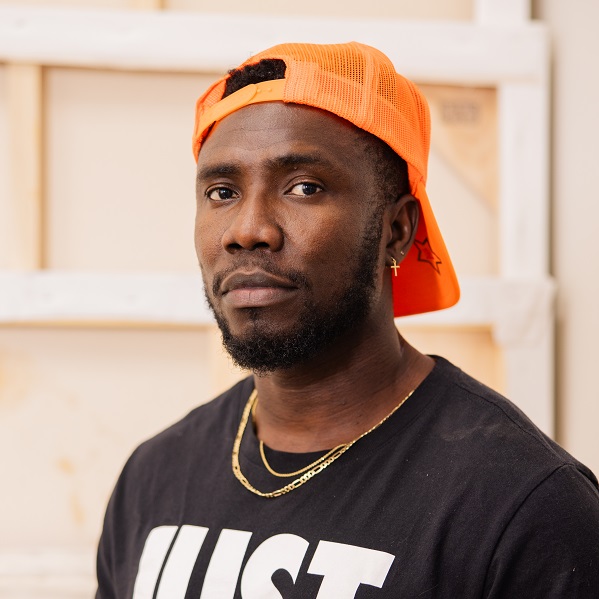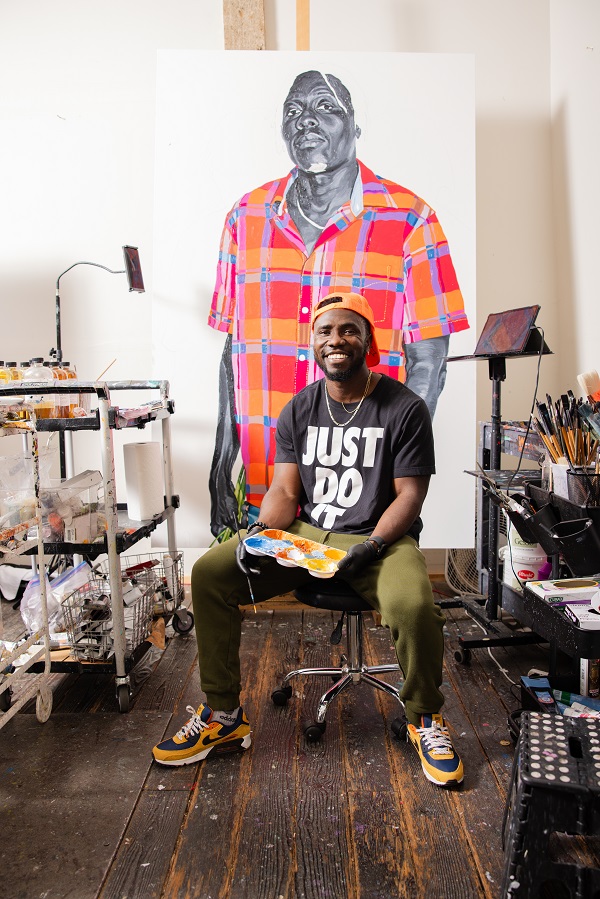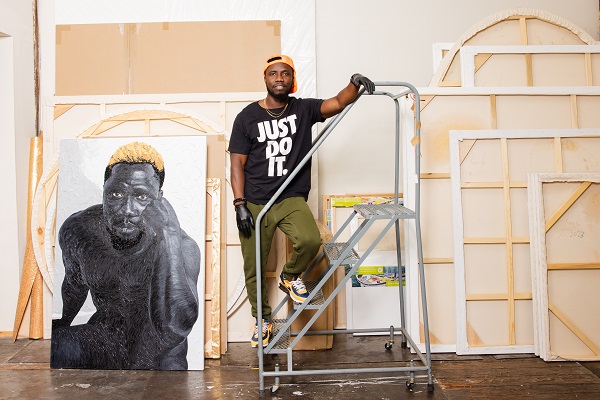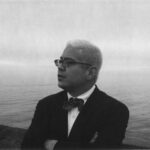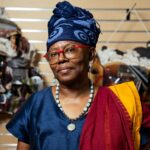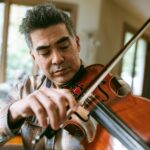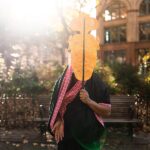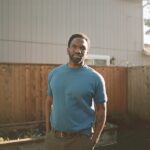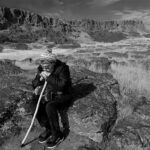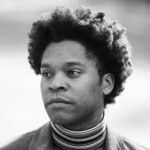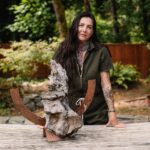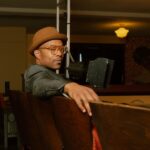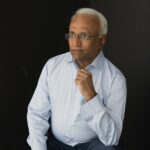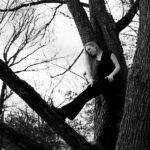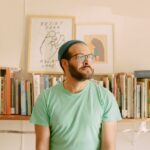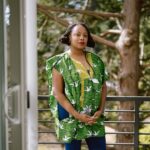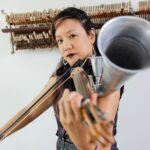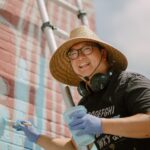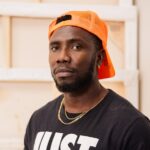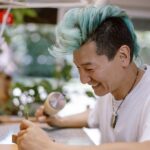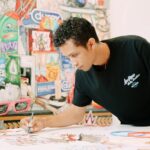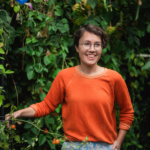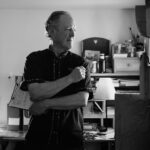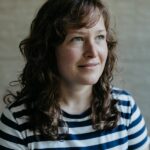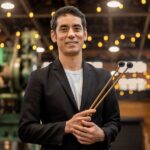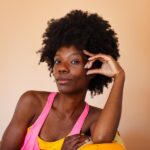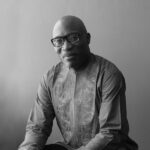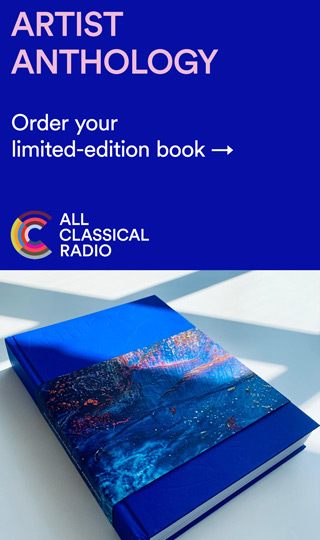Staring Down Oregon Through Paint
Written by Bruce Poinsette; Photographed by Christine Dong
Being a Black Oregonian means navigating simultaneous hypervisibility and invisibility. Trying to shrink yourself or blend into rooms makes you vulnerable. Responding with confidence makes you a threat. It influences not just how we move in general, but how we see and, far too often, don’t see each other.
It’s impossible to divorce this dynamic from Oregon’s legacy as the only state to pass anti-Black exclusion laws. The legacy continues to manifest in local policies to this day: according to fivethirtyeight.com, Portland has the fifth highest Black arrest disparity in the country; Portland police kill Black people nearly four times more often than white; and Black Portlanders continue to disproportionately face displacement by gentrification and city initiatives. This makes the need for Black Oregonians to be seen and command dignity that much more visceral and urgent.
It also calls upon Black artists to make work that stares down Oregon directly. Few works do so quite like the paintings of Otis Kwame Kye Quaicoe.
Quaicoe’s portraits utilize bold, often bright colors and clothing, as well as a focus on the gaze of his subjects—friends, colleagues, and strangers alike—to convey empowerment. Quaicoe often dresses subjects to fit specific themes, such as his interest in cowboys and Westerns. The shading of subjects’ skin contrasts with vibrant attire to capture the viewers’ gaze, while conveying complex Black stories simply through the eyes staring back at them.
“You pick particular clothes for a reason, because you know that when you wear those clothes, it’ll make you feel important or it’ll make you feel powerful or it’ll make you feel happy,” says Quaicoe. “When you look at my subjects in my paintings–the side of the stare, the clothes–it’s about everything.”
Quaicoe shoots photographs of his subjects that he converts to black and white sketches in order to locate the true color source.
“You can capture all that in one shot–the person’s character, their emotions, who the person really is, their stare and everything,” says Quaicoe. “You spend more time getting to know the person than just painting and looking at them getting tired.”
Intisar Abioto—a fellow Portland creative and curator of the Portland Art Museum’s Black Artists of Oregon exhibit, which features Quaicoe’s paintings—calls Quaicoe’s work “epic.”
“I feel like the energy of the folks truly comes through and emanates,” says Abioto. “I think his works are dynamic and alluring.”
Before moving to Portland with his wife Jessica in 2017, Quaicoe grew up and developed his craft in Accra, Ghana. His love for painting began with the hand-painted movie posters he would see on the walls in theaters as a child. He especially enjoyed Westerns, which they called “TNT” movies in Ghana. After finding out those posters were commissioned, he sought out the artists and some gave him lessons.
Continue Reading
“Mixing colors together to create something, I thought it was the most exciting thing ever,” says Quaicoe. “The freedom of expressing yourself with art—it’s just you and paint and color, you can do anything you want. I love that.”
He continued growing his mostly self-taught practice and eventually went to the Ghanatta College of Art and Design in Accra. Moving to the US, and seeing the conditions and plight of Black Americans—both in general, and the way people looked at him differently as a Black man and as an African, in particular—inspired him to focus his work on Black subjects.
“While I’m here, I’m Black,” says Quaicoe. “I’m part of the issues involving Black people. I’m part of how Black people are seen. Whatever I do also affects the African Americans living here. If there will be any change, I will have to be part of that change.”
Black people make up 2.3 percent of Oregon’s population and 5.6 percent in Portland, according to the US Census Bureau. The lack of Black artists being showcased, and the need for Black Oregonians to see themselves in art “has become more prevalent,” says John Goodwin, the Portland Art Museum’s Director of Community Philanthropy. “People are demanding it.”
The hunger for Black exhibits and events that don’t center the white gaze was perhaps no more evident than during the Juneteenth Rodeo, an outgrowth of Eight Seconds—a photobook by Ivan McClellan on contemporary Black cowboys in America, which has expanded to include collaborative portraits between Quaicoe and McClellan. In June, 2023, the rodeo sold out, with a predominantly Black audience.
“Otis and Ivan are doing such incredible work,” Goodwin continued. “Sometimes people think this is a blip in the time where everybody’s excited about Black art now because of the George Floyd situation and Black Lives Matter—in some instances that’s probably true—but if the art is really good, it’ll last forever. Good art always lasts.”
People are often surprised to learn Quaicoe lives in Portland. In fact, he says people often ask why he doesn’t move to New York or Los Angeles. After all, Quaicoe had his breakout moment with his Black Like Me exhibit in 2020, which was featured in LA’s prestigious Roberts Projects gallery. The exhibit, which showcased oil paintings of various Black subjects, earned accolades, and appearances from celebrities like Anderson Cooper and Michael Ealy.
“You grow up watching certain celebrities on TV, and there’s no way you think about meeting them in life,” says Quaicoe. “You imagine yourself at the age of fifty before people start recognizing you.”
In contrast to his LA experience, Quaicoe says it has been much more difficult to find larger acceptance in Portland. He feels a hesitation and resistance here—a lack of open-mindedness or education about modern, contemporary, Black art.
“That’s why my first gallery was in LA and my second gallery is in Europe,” says Quaicoe.
Yet, not only is he not looking to relocate, he’s very much invested in building a more prosperous future for local Black artists.
Quaicoe recently finished a print that will be auctioned to support the Portland Art Museum’s upcoming Black Art and Experiences section—a 24/7 installation that will showcase up-and-coming Black artists.
“For a young person like [Otis] to be giving back to the community like that is tremendous,” says Goodwin. “He’s also helping other artists already, bringing them along, just as Amoako Boafo and Kehinde Wiley brought him along.”
In late 2019, the Ghanaian painter Amoako Boafo invited Quaicoe to a residency in LA that led to the Black Like Me show—and changed Quaicoe’s life. At the time, Quaicoe was working at FedEx and making art on the weekends.
While many are still talking about Black Like Me, Quaicoe has continued growing his craft and making his name known across the globe. His 2022 show BLACK RODEO: Cowboys of the 21st Century, which depicts and explores the stories of Black American cowboys and cowgirls, exhibited at the Almine Rech Gallery in Brussels.
With local recognition rising and his international acclaim growing, Quaicoe’s focus remains the same as the early days: sharing his passion with the world.
“As much as you love painting, you can’t paint and keep having it and keep having it,” he says, visible urgency behind his gaze. “You run out of space. People have to see your work. Enjoy your talent. Enjoy your gift.”

